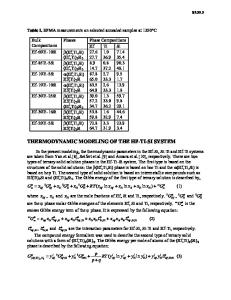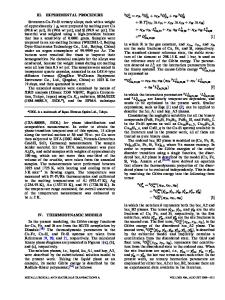Experimental and thermodynamic investigation of the Ni-Al-Mo system
- PDF / 524,369 Bytes
- 11 Pages / 612 x 792 pts (letter) Page_size
- 30 Downloads / 425 Views
I. INTRODUCTION
A NEW generation of turbine-blade materials, necessary for advanced high-performance engines, has been under development for decades. The Ni-Al-Mo system was chosen as a base, since great attention has been focused on directional solidification of fcc(Ni)/L12 (Ni3Al) 1 bcc(Mo) eutectic superalloys, which show excellent properties both at room and at elevated temperatures. Much work has been done to investigate phase stabilities and to establish phase relations, such as that by Henry,[1] Yoshizawa et al.,[2,3] Wakashima et. al.,[4] Nash et al.,[5] Miracle et al.,[6] and Maslenkov et al.[7,8] However, they are not always consistent with each other and even result in contradictions. To fully understand the microstructural evolution of Ni-Al-Mo superalloys during processing and long-term exposure to various working conditions, all related information should be assessed and a complete thermodynamic description should also be obtained for the purpose of further theoretical prediction and simulation. Early work by Kaufman and Nesor[9] has been done to calculate some isothermal sections of the Ni-Al-Mo system. However, due to the lack of experimental data at that time, that work needs to be improved. Recent work by Huang and Chang,[10] Ansara et al.,[11] Saunders,[12] and Cui and Jin,[13] which focused on sub-binary systems of the NiAl-Mo system, have formed the basis of the present work. The objective of the present work is mainly centered on the assessment of thermodynamic parameters of each phase as well as experimental study. II. EXPERIMENTAL INVESTIGATION Almost all experiments conducted on the Ni-Al-Mo system to establish phase relations are based on the method of analyzing the microstructure of alloys (Wakashima et al.,[4] Nash et al.,[5] Miracle et al.,[6] and Maslenkov et al.[7,8]). The diffusion triple technique, on the other hand, as an
XIAOGANG LU and YUWEN CUI, Postdoctoral Students, and ZHANPENG JIN, Professor, are with the Department of Materials Science and Engineering, Central South University of Technology, Hunan 410083, People’s Republic of China. Manuscript submitted August 24, 1998. METALLURGICAL AND MATERIALS TRANSACTIONS A
effective and powerful approach to determining phase diagrams, plays a dominant role in the study of complex metallic systems. Accordingly, this method is utilized in this study. A. Experimental Procedures Starting materials were high-purity aluminum (99.99 wt pct), electrolytic nickel (99.97 wt pct), and a molybdenum bar (99.97 wt pct). Alloys 1 and 2 were prepared by argon are melting on a cooled copper hearth, using a nonconsumable tungsten electrode. Each alloy button was turned over three times and remelted to make it more homogeneous. No significant loss in weight occurred, so the alloys were believed to have the desired compositions. The nominal compositions of the alloys are listed in Table I. Polished bulk Mo and Ni were first bound with thin Mo cords and put into vacuumed (1021 Pa) quartz tubes. After heating in a GK-2B–type diffusion furnace at 1373 K
Data Loading...











